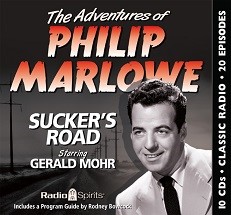
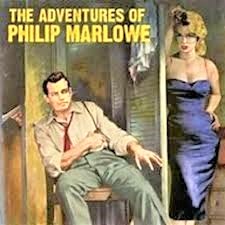 The Adventures of Philip Marlowe (1948-51) aired “The Feminine Touch” on May 7, 1949 as the 32nd of its 114 episodes. This is but the third episode of the show we have showcased here, the first two coming in May and December of 2020. For those coming to the show for the first time I reprise the introductory material from that initial episode.
The Adventures of Philip Marlowe (1948-51) aired “The Feminine Touch” on May 7, 1949 as the 32nd of its 114 episodes. This is but the third episode of the show we have showcased here, the first two coming in May and December of 2020. For those coming to the show for the first time I reprise the introductory material from that initial episode.
The original brief run starring Van Heflin debuted as a summer replacement for The Bob Hope Show from June 17, 1947 – September 19, 1947. For various reasons it didn’t wow audiences, or the creator of the character himself, Raymond Chandler, and so was cancelled, only to be retooled with a new actor as Marlowe (the incomparable Gerald Mohr, 1914-1968) and new scripts.
Mohr was a ubiquitous figure in radio and later in television. Just a few of his more than 500 radio appearances as star or supporting character include: Jungle Jim, Archie Goodwin on The New Adventures of Nero Wolfe, The Whistler, The Shadow of Fu Manchu, Box 13, Escape, and many others. Beginning in the 1950s, Mohr appeared in more than 100 TV series during his life, among them: Maverick, The Lawman, Cheyenne, Sugarfoot, Bonanza, The Rifleman, and other Westerns. Non-western TV appearances included but were not limited to: Perry Mason, 77 Sunset Strip, Hawaiian Eye, and of SF interest episodes of Lost in Space and Voyage to the Bottom of the Sea. Of interest to comic books fans, Mohr did the voice of Reed Richards in The Fantastic Four animated cartoon series in 1967, and that of Green Lantern in the animated Aquaman series in 1968.
Conversant in Swedish, Mohr had flown to Stockholm in the Fall of 1968 to star in the pilot of a proposed television series. Shortly after filming he dropped dead of a heart attack on November 9th, 1968 at the age of 54. He was buried on the island of Lidingo, Sweden.
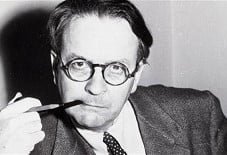 Raymond Chandler (1888-1959, photo at right) wasn’t the first to create what would come to be known as the hard-boiled detective. Dashiell Hammett was first on the scene with his Sam Spade character introduced in his 1930 novel The Maltese Falcon (first serialized beginning in the September 1929 issue of Black Mask magazine). But with Chandler’s first novel, The Big Sleep, published in 1939, he took the gritty, noir detective novel to a new level with his tough as nails private eye, Philip Marlowe. (It should be noted here that the screenplay for the classic 1946 version of the film was co-scripted by William Faulkner, Jules Furthman, and none other than SF’s own Leigh Brackett. It starred Humphrey Bogart as Marlowe and his new real life wife Lauren Bacall as Vivian Rutledge.) Marlowe’s character was not only able to handle himself on the street, he was an intellectual cut above the average gumshoe in that he had attended college, played chess, and had an ear for classical music. This side of his character only masked his off the cuff ability to fling witty descriptions and ready-made similes to pepper his
Raymond Chandler (1888-1959, photo at right) wasn’t the first to create what would come to be known as the hard-boiled detective. Dashiell Hammett was first on the scene with his Sam Spade character introduced in his 1930 novel The Maltese Falcon (first serialized beginning in the September 1929 issue of Black Mask magazine). But with Chandler’s first novel, The Big Sleep, published in 1939, he took the gritty, noir detective novel to a new level with his tough as nails private eye, Philip Marlowe. (It should be noted here that the screenplay for the classic 1946 version of the film was co-scripted by William Faulkner, Jules Furthman, and none other than SF’s own Leigh Brackett. It starred Humphrey Bogart as Marlowe and his new real life wife Lauren Bacall as Vivian Rutledge.) Marlowe’s character was not only able to handle himself on the street, he was an intellectual cut above the average gumshoe in that he had attended college, played chess, and had an ear for classical music. This side of his character only masked his off the cuff ability to fling witty descriptions and ready-made similes to pepper his 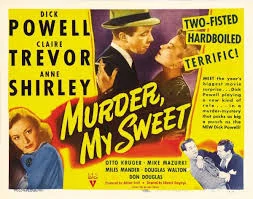 already colorful narratives, and was to become one of his trademarks, emulated by many another writer who wished to show how clever their own detective creations were. It became a widely recognized form of dialogue that later transferred itself well to the silver screen, custom made for audiences eager for the noir crime/detective experience, and was given full voice in the movie adaptation of Chandler’s 1940 novel Farewell, My Lovely. Released in 1944 under the novel’s original title in the UK, for American audiences the title was changed to Murder, My Sweet and starred Dick Powell and Claire Trevor. It was a well-received, seminal film that helped define the noir genre, and was a breakthrough role for Powell as well, who had spent a good decade or more playing the young, handsome, crooning playboy roles but never the serious leading man.
already colorful narratives, and was to become one of his trademarks, emulated by many another writer who wished to show how clever their own detective creations were. It became a widely recognized form of dialogue that later transferred itself well to the silver screen, custom made for audiences eager for the noir crime/detective experience, and was given full voice in the movie adaptation of Chandler’s 1940 novel Farewell, My Lovely. Released in 1944 under the novel’s original title in the UK, for American audiences the title was changed to Murder, My Sweet and starred Dick Powell and Claire Trevor. It was a well-received, seminal film that helped define the noir genre, and was a breakthrough role for Powell as well, who had spent a good decade or more playing the young, handsome, crooning playboy roles but never the serious leading man.
As for “The Feminine Touch,” it begins as many a Philip Marlowe radio adventure does, with a dramatic tease introducing the crucial elements of the episode, and which in this case just about says all you need to know. So without further ado, enjoy “The Feminine Touch” and the introduction to this Philip Marlowe mystery:
An iron skull was their trademark.
Their business was climbing walls, and it was all done on wheels at 70 miles an hour.
But that was a cinch for the death cheaters until they felt murder, and a feminine touch.
(This episode is included in the CD linked at top left.)
Play Time: 29:10
{With summer vacation less than a handful of weeks away and the Spring weather promising hints of Summer outside classroom windows, the neighborhood gang could barely pay attention to their studies. Thank goodness for weekends and radio programs like the Philip Marlowe episode they listened to on Saturday evenings in May of 1949, for it primed them to head for the corner newsstand the next day (after Church) to discover more stories in the general vein of those portrayed in The Adventures of Philip Marlowe. Detective Tales (1935-53) had long been a favorite when the mood hit them, and this issue held just what they were looking for in a magazine known for its gritty escapism where the Good Guys fought hard to defeat the Bad Guys. Detective Tales was a monthly in 1949. F.B.I. Detective Stories (1949-51) ran its fiction pretty much in line with what its title implied, and it was a successful effort…for awhile. But times were changing and for various reasons another new detective magazine–even one devoted to the famous institution of the FBI, never took off. The magazine lasted but 14 issues, was bi-monthly, with its July 1951 issue being its last. Ten Detective Aces (1928-49) was one of the most long lived of the detective pulps, starting off as The Dragnet Magazine, but changing it title and focus in the early 1930s from gang and organized crime (readers had begun to tire of this storyline) to the more traditional detective brand of Good Guys vs. Bad Guys. It ran a remarkable 16 years under this new title and the switch in story focus was proven correct, and profitable. Though a bi-monthly, it managed only 5 of its 6 issues in 1949 with the September issue its last.}
[Left: Detective Tales, 5/49 – Center: F.B.I. Detective Stories, 4/49 – Right: Ten Detective Aces, 5-49]
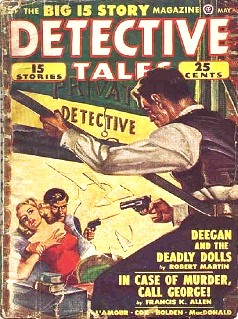
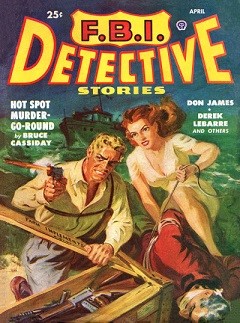
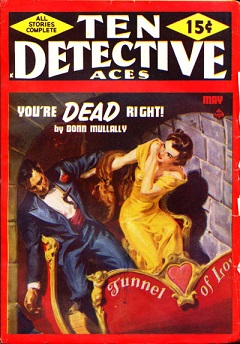
To view the entire list of Old Time Radio episodes go here.